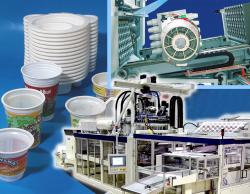plasticker-News
| 2010-09-21 |

|
ILLIG: Thermoforming Pushed to High-Performance
  High-performance production line with RDK 90 automatic pressure forming machine. Like here, shown for the 16-up tray tool, a tool change device facilitates a fast change of format parts and tool. And with the new ILLIG ThermoLineControl the standard effort required for tool installation and removal, among others, is also reduced to a minimum. " href="../images/news/11467_f.02.jpg" class="thickbox" title=""> On the RDK 90 production line, which is the largest version of these automatic pressure forming machines, featuring up to 900 mm processable material width and 700 mm index length, trays are produced just like those sold millions of times as sales and keep-fresh packages for food articles, by processing APET on a 18-up tool at a speed of 55 cycles/min. Yogurt cups are produced on RDM 70K automatic forming machine, forming area 680 x 300 mm², using a 27-up tool and also APET material. Downstream equipment ensures reliable handling of these large numbers of products – 50 000 trays and almost 70 000 yogurt cups. For this purpose the RDK 90 line is equipped with double-handling system for product removal and stacking device. The stacking device of the RDM-K line is equipped with a new turning head system that can be swiveled by 180 degrees. Designed for a speed of up to 45 cycles/min, the demolded cups can cool down further for one cycle to ensure gentle stacking.  Thermoformers of RDM-K series designed for cup-shaped products of various sorts: Use of 3rd Generation tool technology with reduced forming air volume and dynamic forming pressure build-up results in high cycle speeds and improved product quality at the same time. Top right: Fast cup removal and gentle stacking with new turning head system which can be swiveled by 180 degrees. Photos: ILLIG
Consistent use of servo motor drives and new control concept Consistent use of servo motor drives for all motion sequencing is one of the pre-requisites to achieve high cycle speeds in thermoformers. They work in an energy-saving manner, as well as fast and precisely and thanks to high positioning and repetition accuracy maximum overlapping of working steps can be realized which saves process time. The very high dynamics involved in forming pressure build-up and reduction is a further decisive element for the clearly improved productivity compared to the previous generation. In the RDM-K series 3rd Generation tools are the decisive factor. They operate with up to 75 % less forming air volume per cavity and in this way increases in cycle speed of at least 30 % and sometime even considerably higher are possible. In thermoforming with multi-cavity tools, also with respect to product quality, uniformity of all cup geometries is achieved which was not possible before. Based on this, weight reduction and thus material saving of up to 10 percent can even be realized, without having to accept impairment of dimensional accuracy or cup stability. Developed for the first time for the large-size RDK 90, roll-fed thermoformers – like RDM 70K that will be demonstrated for cup production at K fair – can be consistently equipped with the new "ILLIG ThermoLineControl" concept. All additional devices and lines required for the completion of a production line, from material roll stand through to additional cooling devices, can now be centrally managed and operated via the thermoformer´s control. Besides providing an increase in operator convenience, e.g. by central process optimization, data management or process visualization, even the non-productive secondary times needed for format or tool changes are considerably reduced. Moreover, error diagnosis and trouble shooting can be carried out much easier and faster. In this way the new ThermoLineControl combined with the high cycle speeds of today´s machine generation contributes to a considerable increase in creation of value. Energy efficiency significantly increased in thermoforming Servo motor drives used for all movements of the thermoformers not only contribute to an increase in productivity, they have an equally positive effect on the energy balance. The supply units employed are equipped with energy recovery systems. The available generative energy from the system, e.g. braking energy from one or several drives, is used for other drives or other loads, among others also tor the infrared heater. Subject to machine type and drive this saving amounts up to approx. 20 % of the drive energy. The energy efficiency topic, however, is much more complex for thermoforming since the machine drives require maximally approx. 10 to 15 % (subject to machine type) of the whole energy requirement in the thermoforming process. Among others, the following are also influential elements: Type and use of infrared heater elements for material heating, energy requirement of temperature control and cooling devices and – for automatic roll-fed machines working predominantly with pressure air a very important "energy factor" – energy requirement for generation of forming air. In their K trade fair booth ILLIG will illustrate these interrelationships based on practical examples. They will show how high productivity in thermoforming (high cycle speeds) can be combined at the same time with efficient energy consumption that saves operation costs. Comparative measurements conducted on ILLIG machines of previous generations revealed that today´s 3rd Generation thermoformers which are considerably more efficient feature up to 50 % less energy consumption. More Information: www.illig.de K 2010, 27.10.–3.11.2010, Düsseldorf, Hall 3, Stand A52 |
ILLIG Maschinenbau GmbH & Co. KG, Heilbronn, Germany
 back to news list back to news list |  back to top back to top |











